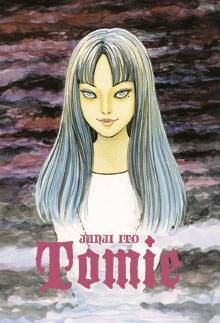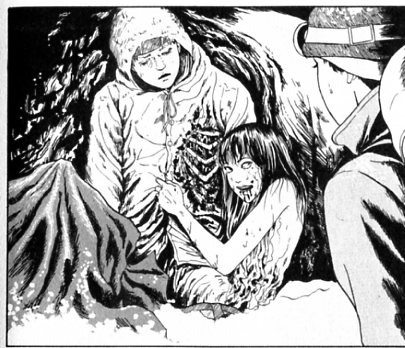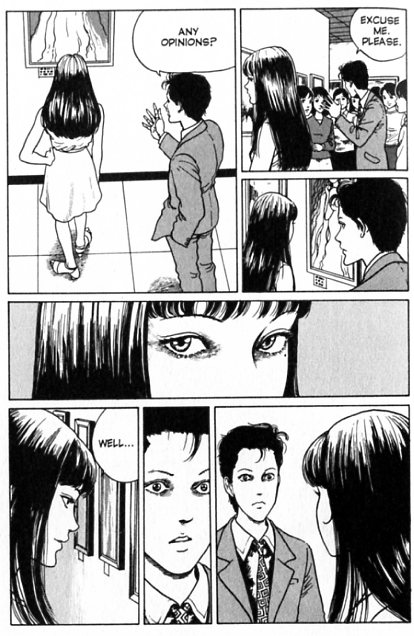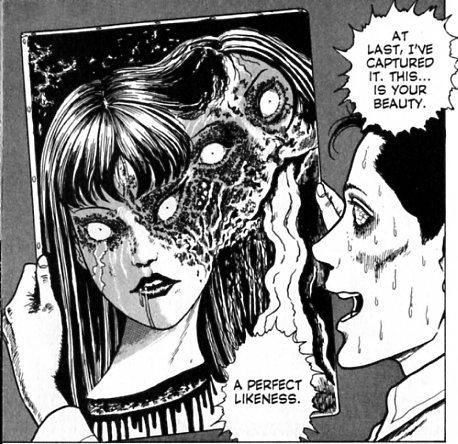I had a pretty interesting conversation with Jason Thompson about Junji Ito’s Tomie stories and related matters on Twitter. Seemed a shame to just let it disappear into the twitter-hole, so I thought I’d reprint it over here.
Jason started out:
Nice article on Junji Ito’s Tomie. While it’s always interesting to analyze undercurrents in horror fiction, I’m resigned that these currents are usually reactionary. In real horror, there IS no role for any character, male or female, other than villain or victim. Horror which has any kind of positive or empowering message to any group isn’t really horror. Action-horror, maybe. ‘Aliens’, thus, is action-horror, not horror, because Sigourney Weaver kicks ass at the end. Contrarily, Night of the Living Dead is horror because the heroine is catatonic/useless and the hero gets killed pointlessly. The ‘update’ of Romero’s catatonic heroine, I guess, is Tobe Hooper’s heroine in Chainsaw 2, who ends up a manic/deranged killer. But any horror story which ends with the protagonist in a better space than they started isn’t much of a horror story, IMHO.
I replied:
Glad you liked the piece! I’m always pretty leery of defining “real” horror. Genres are arbitrary demarcations, and designed to crossbreed. In any case, I don’t think “progressive” means “uplifting.” Presenting a bleak worldview can easily have progressive overtones (as in the Stepford Wives.) I’d agree that Ito is fairly regressive…but that’s because of how he deals with gender, not because the stories are bleak. Not even clear they are bleak, exactly; you never care about the characters; the whole point is to kill them off. It’s gruesome…but not sad. Probably meant to be exhilarating/funny/cool more than anything.
And Jason finished up:
Very true, Stepford Wives is a good example! You reminded me, Ito also did an (untranslated) 1-shot graphic novel about a beautiful bishonen who ensnares’ women’s souls. Yet even in that story, it’s the women zombies eternally following the ghostly bishonen who are the true sources of disgust. ;) That said, I think if Tomie were sorta the ‘heroine’ avenging herself on men the stories wouldn’t be very scary/very good horror. Tomie is definitely about men’s fascination/disgust with the female body. Tomie’s personality attributes are all stereotypes of the femme fatale, including her obliviousness/shallowness. Tomie’s shallowness is such she doesn’t even seem ‘aware’ she’s a monster in most stories. This must be meant as a comedy element.. …while sort of reinforcing her as an inhuman ‘thing’ that doesn’t really act, it just reacts. Dave Sim could get with that idea. So yeah, it’s pretty sexist (or self-consciously plays with sexist imagery? Who knows). But I wouldn’t be a HP Lovecraft fan if I couldn’t stand seeing offensive ideas played out in genre form to their logical extreme.
Now I’m thinking of “The Iron Dream”, Norman Spinrad’s exploration of ‘what if Hitler were a genre author’…
Pardon the ramble! It’d be interesting to see an essay on the depiction of women throughout Ito’s work… The ‘heroine’ of Uzumaki is pretty much a reactive figure too (though so is every character in that story of predestination).





